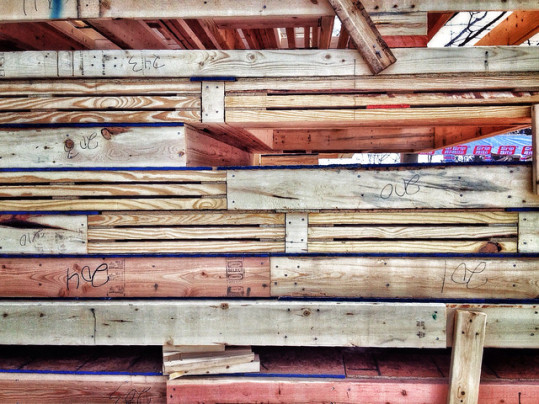Housing conditions are largely dictated by supply and demand. Take a look at the balance of interested buyers to available homes and you can get a good idea where the market is headed. But while that seems simple enough, the underlying factors that cause shifts in supply and demand are less clear cut. That’s because there are an almost infinite number of things that might play a role. Everything from the global economy to the time of year can affect the balance of buyers and homes for sale. For example, the typical home buyer likely doesn’t think a lot about how the cost of lumber affects how much they’ll pay for a home. It does, though. In fact, according to the National Association of Home Builders, lumber prices have been high for a while now and, since mid-April, have moved even higher. The reasons have to do with a lack of domestic production and tariffs on Canadian lumber. However, the affect is that home builders have to add that cost to the price of new homes. That can slow the number of homes being built and drive the price up on the ones that are. Ultimately, that means high lumber costs hinder home building, which contributes to a lack of affordable inventory and higher home prices across the board. (source)
Archive for August 2020
Americans Say Now Is A Good Time To Sell
Fannie Mae’s Home Purchase Sentiment Index surveys Americans about their feelings toward the housing market, buying and selling a home, job expectations, and their personal financial situation. The monthly survey aims to get a general sense of how optimistic Americans are about their money and the real estate market. In July, the index fell 2.3 points, following two consecutive months of gains. The decline was mostly due to a drop in the number of respondents who said it was a good time to buy a home. However, there was an uptick in participants who said it was a good time to sell. In fact, the net share of those who say it’s a good time to sell was up 4 percent. Doug Duncan, Fannie Mae’s senior vice president and chief economist, says that’s mostly due to home price expectations. “Supply constraints appear to be applying upward pressure to consumers’ home price expectations, which in turn has contributed to both a sharp reversal in optimism about whether it is a good time to buy a home and further improvement in home-selling sentiment,” Duncan said. Also in the report, the number of respondents who said they weren’t concerned about losing their job in the next year was up 5 percent – potentially a good sign for future housing sentiment. (source)
Number Of Equity Rich Homeowners Grows
Simply put, having equity means your home is worth more than the amount you owe on it. And, according to ATTOM Data Solutions’ second-quarter 2020 U.S. Home Equity & Underwater Report, there are an increasing number of American homeowners who have it. The report looked at the number of mortgaged properties that could be considered equity rich, which was defined as homes whose estimated market value is at least 50 percent more than the amount owed on them. During the second quarter, 27.5 percent of the 55.2 million mortgaged homes in the country qualified as equity rich. That’s up from 26.5 percent during the first quarter. Todd Teta, chief product officer with ATTOM, says the improvement is another sign of the market’s strength despite a challenging environment. “Homeowners saw their equity rise far and wide throughout the United States during the second quarter of this year in yet another sign of the housing market punching back against the coronavirus pandemic,” Teta said. “More property owners rose into equity-rich territory and escaped the seriously underwater lane, putting more money into the average household.” (source)
Mortgage Rates Hit Another Record Low
According to the Mortgage Bankers Association’s Weekly Applications Survey, average mortgage rates fell to another record low last week, with rates declining for 30-year fixed-rate loans with conforming balances, jumbo loans, and 15-year fixed-rate loans. Rates for mortgages backed by the Federal Housing Administration were flat from one week earlier. But despite favorable rates, demand for mortgage applications still fell 5.1 percent from the week before. Joel Kan, MBA’s associate vice president of economic and industry forecasting, says demand remains strong. “Purchase applications also fell slightly, but were still 20 percent higher than a year ago and have now risen year-over-year for 11 straight weeks,” Kan said. “Purchase loan balances continued to climb, which is perhaps a sign that the still-weak job market and tighter credit for government loans are constraining some first-time home buyers.” The MBA’s weekly survey has been conducted since 1990 and covers 75 percent of all retail residential mortgage applications. (source)
What Are The Top Challenges For Today’s Buyers?
Everybody’s home search is different. Where one buyer may fall in love, make an offer, and sign a contract after seeing a single house, another may spend weeks without finding a home that fits their needs and lifestyle. In short, how long it takes to locate and close on a house depends on a long list of factors, personal preferences, and conditions. So what do buyers who’ve been searching say is the number one thing making it difficult to find a home? Well, according to a new report from the National Association of Home Builders, it’s finding a home in their price range. In fact, 39 percent of respondents who have been actively searching for a home said that finding one at a price they could afford was the biggest obstacle. Another common factor was finding a house that had all of the buyer’s desired features. Among participants, 36 percent said they were having trouble finding a home that checked off the items on their wish list. Being outbid by another buyer and finding a home in the right neighborhood were also popular answers, with both being named by around 30 percent of survey participants. (source)
Homes For Sale Still Trailing Year Ago Levels
In a lot of ways, current housing market data looks almost unaffected by the coronavirus pandemic. Home sales have rebounded and are ahead of last year’s pace. Mortgage rates remain low, hovering just above, or at, all time lows. Buyer demand is up, competition is rising, and prices continue to climb. In short, from the numbers, the housing market is outpacing last year and in-line with forecasts from the beginning of the year. However, there is one housing stat that, more than the others, shows the coronavirus’ impact on the market. The number of homes available for sale is now, according to one analysis, 26.3 percent below where it was last year at the same time. Similarly, new for-sale listings are down 12.2 percent. In other words, low inventory – which was already the market’s main challenge – has been made worse by the pandemic. Homeowners aren’t putting their homes on the market and the imbalance could begin to dampen buyer demand and threaten affordability levels. Fortunately, since conditions are favorable for sellers right now, there’s reason to be optimistic that listings will increase and help bring better balance to the market. (source)
Remote Work Is Influencing Decisions To Buy
Typically, home shoppers would have to take their daily commute into consideration when weighing whether or not to buy a particular house. After all, no one likes sitting in traffic. So, generally speaking, the closer to work you live, the better. These days, though, the coronavirus has changed the way we work and it’s beginning to change how and where we live as well. In short, the fact that more Americans are able to work from home is starting to drive decisions about whether and where to buy a house. For example, a recent survey conducted on behalf of the National Association of Realtors’ consumer website found that 63 percent of respondents who were planning on buying a home in the next year indicated their decision was influenced by their ability to work remotely. George Ratiu, senior economist for the site, says the pandemic has given potential buyers options they didn’t previously have. “The ability to work remotely is expanding home shoppers’ geographic options and driving their motivation to buy, even if it means a longer commute, at least in the short term,” Ratiu said. “Although it’s too early to tell what long-term impact the COVID-era of remote work will have on housing, it’s clear that the pandemic is shaping how people live and work under the same roof.” (source)







